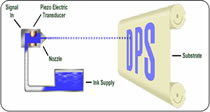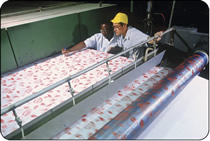global locations
contact
site map
log in
Printing
Digital printing
Digital printing adapted for textiles represents the future of textile printing with its speed, flexibility, infinite color capability, new visual effects, environmental friendliness and potential cost savings. The Cha Group is in the forefront of this research, and is also an active user.
Drop-on-demand inkjet technology utilizing piezoelectric crystal (or simply Piezo) heads is currently the most widely used. This technology relies on pressure, not heat (as in thermal technology). The piezoelectic crystals are activated by an electrical impulse which then expands to force the ink out through a nozzle as a droplet onto the substrate.
Wax resist printing
Originating in the 17th century, the ancient technique known as "batik"
produced wax prints by printing a rosin paste (wax) on both sides of the
fabric in the desired patterns, and then applying a mechanical treatment
to produce the characteristic cracking effects. The fabric is then dyed
with the areas where the wax was applied "resisting" the dye.
After the wax was removed, wooden hand blocks imprinted with the designs
were used to press onto the fabric before re-dyeing with other colors.
Now, modern techniques utilize engraved rotary screens to continuously print designs of any size onto fabric. This has become the most common printing method in use today.
Discharge printing
This method is done on previously dyed fabrics to which a "discharge paste" is then applied to remove the color from the dyed fabric in the patterns desired. Afterwards, the fabric is steamed to "fix" the design print. Usually used to create lighter prints on dark backgrounds, since better dark background colors can be obtained through dyeing than printing.

